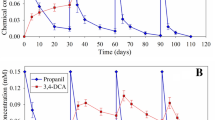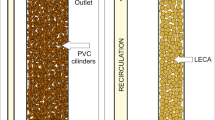Abstract
The persistence of propanil in soil and aquatic environments along with the possible accumulation of toxic degradation products, such as chloroanilines, is of environmental concern. In this work, a continuous small-scale bioprocess to degrade the herbicide propanil, its main catabolic by-product, 3,4-dichloroaniline (3,4-DCA), and the herbicide adjuvants is carried out. A microbial consortium, constituted by nine bacterial genera, was selected. The isolated strains, identified by amplification and sequencing of their 16S rDNA, were: Acidovorax sp., Luteibacter (rhizovicinus), Xanthomonas sp., Flavobacterium sp., Variovorax sp., Acinetobacter (calcoaceticus), Pseudomonas sp., Rhodococcus sp., and Kocuria sp. The ability of the microbial consortium to degrade the herbicide was evaluated in a biofilm reactor at propanil loading rates ranging from 1.9 to 36.8 mg L−1 h−1. Complete removal of propanil, 3,4-DCA, chemical oxygen demand and total organic carbon was obtained at propanil loading rates up to 24.9 mg L−1 h−1. At higher loading rates, the removal efficiencies decayed. Four of the identified strains could grow individually in propanil, and 3,4-DCA: Pseudomonas sp., Acinetobacter calcoaceticus, Rhodococcus sp., and Xanthomonas sp. The Kokuria strain grew on 3,4-DCA, but not on propanil. The first three bacteria have been related to biodegradation of phenyl urea herbicides or chlorinated anilines. Although some strains of the genera Xanthomonas and Kocuria have a role in the biodegradation of several xenobiotic compounds, as far as we know, there are no reports about degradation of propanil by Xanthomonas or 3,4-DCA by Kocuria species.





Similar content being viewed by others
References
Aburto A, Peimbert M (2011) Degradation of benzene-toluene mixture by hydrocarbon adapted bacterial communities. Ann Microbiol 61:553–562
Aburto A, Fahy A, Coulon F, Lethbridge G, Timmis KN, Ball AS, McGenity TJ (2009) Mixed aerobic and anaerobic microbial communities in benzene-contaminated groundwater. J Appl Microbiol 106:317–328
Ahmed RZ, Ahmed N, Gadd GM (2010) Isolation of two Kocuria species capable of growing on various polycyclic aromatic hydrocarbons. Afr J Biotechnol 9:3611–3617
Albrecht K, Frisch G (1989) Liquid pesticidal compositions in the form of suspension concentrates. US Patent 4, 804, 399
Bartha R (1971) Fate of herbicide-derived chloroanilines in soil. J Agr Food Chem 19:385–387
Bevinakatti HS, Waite AG (2012) Surfactant compounds. US Patent 8, 097, 564
Call DJ, Poirier SH, Knuth ML, Harting SL, Lindberg CA (1987) Toxicity of 3,4-dichloroaniline to fathead minnows, Pimephales promelas, in acute and early life-stage exposures. Bull Environ Contam Toxicol 38:352–358
Carvalho G, Marques R, Lopes AR, Faria C, Noronha JP, Oehmen A, Nunes OC, Reis MAM (2010) Biological treatment of propanil and 3,4-dichloroaniline: kinetic and microbiological characterisation. Water Res 44:4980–4991
Correa IE, Steen WC (1995) Degradation of propanil by bacterial isolates and mixed populations from a pristine lake. Chemosphere 30:103–116
Cox C, Surgan M (2006) Unidentified inert ingredients in pesticides: implications for human and environmental health. Environ Health Persp 114:1803–1806
Danchour A, Bitton G, Coste CM, Bastide J (1986) Degradation of the herbicide propanil in distilled water. Bull Environ Contam Toxicol 36:556–562
Dejonghe W, Berteloot E, Goris J, Boon N, Crul K, Maertens S, Höfte M, De Vos P, Verstraete W, Top EM (2003) Synergistic degradation of linuron by a bacterial consortium and isolation of a single linuron-degrading Variovorax strain. Appl Environ Microbiol 69:1532–1541
Eke KR, Barnden AD, Tester DJ (1996) Impact of agricultural pesticides on water quality. In: Hester RE, Harrison RM (eds) Agricultural chemicals and the environment. Issues in environmental science and technology, vol 5. The Royal Society of Chemistry, UK, pp 43–56
Felske A, Engelen B, Nübel U, Backhaus H (1996) Direct ribosome isolation from soil to extract bacterial rRNA for community analysis. Appl Environ Microbiol 62:4162–4167
Galhano V, Gomes-Laranjo J, Fernández-Valiente E, Videira R, Peixoto F (2011) Impact of herbicides on non-target organisms in sustainable irrigated rice production systems: state of knowledge and future prospects. In: Kortekamp A (ed) Herbicides and environment. InTech, Rijeka, pp 45–72
Garrido EM, Lima JLFC, Delerue-Matos C, Borges F, Silva AMS, Oliveira Brett AM (2001) Electrochemical oxidation of propanil and related N-substituted amides. Anal Chim Acta 434:35–41
Golby S, Ceri H, Gieg LM, Chatterjee I, Marques LL, Turner RJ (2012) Evaluation of microbial biofilm communities from an Alberta oil sands tailings pond. FEMS Microb Ecol 79:240–250
Gómez-De Jesús A, Romano-Baez FJ, Leyva-Amezcua L, Juárez-Ramírez C, Ruiz-Ordaz N, Galíndez-Mayer J (2009) Biodegradation of 2,4,6-trichlorophenol in a packed-bed biofilm reactor equipped with an internal net draft tube riser for aeration and liquid circulation. J Hazard Mater 161:1140–1149
Hildebrandt A, Lacorte S, Barceló D (2007) Assessment of priority pesticides, degradation products, and pesticide adjuvants in groundwaters and top soils from agricultural areas of the Ebro river basin. Anal Bioanal Chem 387:1459–1468
Hoagland RE, Zablotowicz RM, Locke MA (1994) Propanil metabolism by rhizosphere microflora. In: Anderson TA, CoatsJR (eds) Bioremediation through rhizosphere technology. ACS Symposium Series, vol 563. American Chemical Society, USA, pp 160–183
Hongsawat P, Vangnai AS (2011) Biodegradation pathways of chloroanilines by Acinetobacter baylyi strain GFJ2. J Hazard Mater 186:1300–1307
Hund-Rinke K, Simon M (2005) Terrestrial ecotoxicity of eight chemicals in a systematic approach. J Soils Sedim 5:59–65
Jak RG, Maas JL, Scholten MCTH (1998) Ecotoxicity of 3,4-dichloroaniline in enclosed freshwater plankton communities at different nutrient levels. Ecotoxicol 7:49–60
Janke D, Baskunov BP, Nefedova MY, Zyakun AM, Golovleva LA (1984) Incorporation of 18O2 during cometabolic degradation of 3-chloroaniline by Rhodococcus sp. An 117. J Basic Microbiol (Zeitschrift für allgemeine Mikrobiologie) 24(4):253-259. doi:10.1002/jobm.19840240411
Jones R (2005) The ecotoxicological effects of photosystem II herbicides on corals. Mar Pollut Bull 51:495–506
Ju K-S, Parales RE (2011) Evolution of a new bacterial pathway for 4-nitrotoluene degradation. Mol Microbiol 82:355–364
Karn SK, Chakrabarti SK, Reddy MS (2011) Degradation of pentachlorophenol by Kocuria sp. CL2 isolated from secondary sludge of pulp and paper mill. Biodegradation 22:63–69
Kaufman DD, Blake J (1973) Microbial degradation of several acetamide, acylanilide, carbamate, toluidine and urea pesticides. Soil Biol Biochem 5:297–308
Konstantinou IK, Sakkas VA, Albanis A (2001) Photocatalytic degradation of the herbicides propanil and molinate over aqueous TiO2 suspensions: identification of intermediates and the reaction. Appl Catal B-Environ 34:227–239
Leigh MB, Prouzová P, Macková M, Macek T, Nagle DP, Fletcher JS (2006) Polychlorinated biphenyl (PCB)-degrading bacteria associated with trees in a PCB-contaminated site. Appl Environ Microbiol 72:2331–2342
Mackay D, Shiu WY, Ma K-C, Lee SC, (2006) Handbook of physical-chemical properties and environmental fate for organic chemicals, 2nd ed vol IV, Nitrogen and sulfur compounds and pesticides. CRC Press Boca Raton FL, USA, pp 3639–3641
Parshetti GK, Telke AA, Kalyani DC, Govindwa SP (2010) Decolorization and detoxification of sulfonated azo dye methyl orange by Kocuria rosea MTCC 153. J Hazard Mater 176:503–509
Pino N, Peñuela G (2011) Simultaneous degradation of the pesticides methyl parathion and chlorpyrifos by an isolated bacterial consortium from a contaminated site. Int Biodeter Biodegr 65:827–831
Sahid IB, Carso J, Chuah TS (2011) Resistance mechanism of Leptochloa chinensis Nees, to propanil. Weed Biol Manag 11:57–63
Shen L, Xu H, Liu Y (2011) Microbial characterization of the biofilms developed for treating ampicillin-bearing wastewater. J Environ Sci Health A 46:314–322
Solyanikova IP, Baskunov BP, Baboshin MA, Saralov AI, Golovleva LA (2012) Detoxification of high concentrations of trinitrotoluene by bacteria. Appl Biochem Microbiol 48:21–27
Sørensen SR, Albers CN, Aamand J (2008) Rapid mineralization of the phenylurea herbicide diuron by Variovorax sp. strain SRS16 in pure culture and within a two-member consortium. Appl Environ Microbiol 74:2332–2340
Sun B, Ko K, Ramsay JA (2011) Biodegradation of 1,4-dioxane by a Flavobacterium. Biodegradation 22:651–659
Taylor EJ, Maund SJ, Bennet D, Pascoe D (1994) Effects of 3,4-dichloroaniline on the growth of two freshwater macroinvertebrates in a stream mesocosm. Ecotox Environ Safe 29(1):80–85
Tobiassen LS, Nielsen E, Nørhede P, Ladefoged O (2003) Report on the health effects of selected pesticide coformulants. Pesticides Research Nr. 80, Danish Veterinary and Food Administration, Institute of Food Safety and Nutrition, Danish Environmental Protection Agency
Vangnai AS, Petchkroh W (2007) Biodegradation of 4-chloroaniline by bacteria enriched from soil. FEMS Microbiol Lett 268:209–216
Vidal L, Christen P, Coello MN (2000) Feather degradation by Kocuria rosea in submerged culture. World J Microbiol Biotech 16:551–554
Wang C, Lu G-H, Zhou Y-J (2007) Biodegradablilty of chlorinated anilines in waters. Biomed Environ Sci 20:141–145
Wang L, Wang G-L, Li S-P, Jiang J-D (2011) Luteibacter jiangsuensis sp. nov.: a methamidophos-degrading bacterium isolated from a methamidophos-manufacturing factory. Curr Microbiol 62:289–295
Water Analysis Handbook, 4th Edition (2002) Hach Company, Loveland, Co., USA, pp 221–224, 731–736, 743–749
Wendel C, Mason T (2009) Risks of propanil use to federally threatened California red-legged frog. Environmental fate and effects. Division office of pesticides program, Washington DC http://www.epa.gov/espp/litstatus/effects/redleg-frog/#propanil. Accessed 12 July 2012
Zhang LJ, Chen L, Thring RW (2011) Remediation of refinery oily sludge using isolated strain and biosurfactant.In: Proceedings of 2011 International symposium on water resource and environmental protection, Xi’an China, 20–22 may 2011, vol 3, pp 1649–1653
Acknowledgments
The authors wish to thank COFAA-IPN and SIP-IPN for financial support for fellowships to C. J-R, N. R-O, and J. G-M, and to Conacyt for graduate scholarships to V.E. H-G.
Author information
Authors and Affiliations
Corresponding author
Rights and permissions
About this article
Cite this article
Herrera-González, V.E., Ruiz-Ordaz, N., Galíndez-Mayer, J. et al. Biodegradation of the herbicide propanil, and its 3,4-dichloroaniline by-product in a continuously operated biofilm reactor. World J Microbiol Biotechnol 29, 467–474 (2013). https://doi.org/10.1007/s11274-012-1200-5
Received:
Accepted:
Published:
Issue Date:
DOI: https://doi.org/10.1007/s11274-012-1200-5




